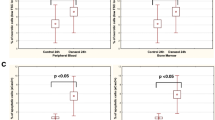Abstract
Induction of apoptosis in vitro using gemcitabine (dFdC) in combination with cladribine (2-CdA) and other cytotoxic drugs on malignant mononuclear cells (MNCs) of patients with acute myeloid leukemia (AML, n=20) and chronic lymphocytic leukemia (CLL, n=20) in myeloid (HL60, HEL) and lymphatic cell lines (HUT78, JURKAT) was investigated using different incubation conditions (simultaneous and consecutive). Furthermore, the influence of dFdC on the level of intracellular metabolites of 2-CdA was studied using high-performance liquid chromatography (HPLC). Apoptosis was evaluated using flow cytometry with 7-aminoactinomycin D. In MNCs of patients with CLL, dFdC+2-CdA showed an antagonistic effect when applied simultaneously. This antagonism was reduced by consecutive application. The combination of dFdC with doxorubicin was synergistic, independent of incubation schedule. In blasts from newly diagnosed patients with de novo AML, all drug combinations (dFdC+2-CdA, doxorubicin, or cytosine arabinoside) were antagonistic by simultaneous incubation. Reduced antagonism or even synergism was shown (P<0.001) by consecutive incubation. The simultaneous combination of dFdC with 2-CdA in all tested cell lines resulted in a competitive inhibition on the rate of apoptosis. By changing the incubation period to a consecutive schedule, the antagonism was diminished or synergism of apoptosis was measured (P<0.001). Using similar incubation conditions, these experiments were supported by HPLC measurement of intracellular metabolites of 2-CdA influenced by dFdC application. In conclusion, we demonstrated that the efficacy of dFdC in vitro in combination with other cytotoxic drugs depends on the incubation condition and on the origin of neoplastic cells (lymphatic vs myeloid). The data suggest that simultaneous combination therapy with purine and pyrimidine analogues may not improve the clinical efficacy of one or the other drug administered alone.
Similar content being viewed by others
Author information
Authors and Affiliations
Additional information
Received: 4 November 1999 / Accepted: 28 January 2000
Rights and permissions
About this article
Cite this article
Chow, K., Ries, J., Weidmann, E. et al. Induction of apoptosis using 2′,2′difluorodeoxycytidine (gemcitabine) in combination with antimetabolites or anthracyclines on malignant lymphatic and myeloid cells. Antagonism or synergism depends on incubation schedule and origin of neoplastic cells. Ann Hematol 79, 485–492 (2000). https://doi.org/10.1007/s002770000181
Issue Date:
DOI: https://doi.org/10.1007/s002770000181




